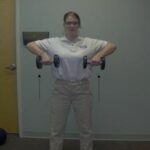When Peter returned for the third time in five years to see his orthopedic surgeon, he was finally ready to undergo rotator cuff surgery. The doctor took another set of X-rays, then surprised his patient by announcing that the rotator cuff injury had healed. The problem, he advised, was bursitis in Peter’s shoulder. They then discussed treatment options.
What is shoulder bursitis?
Bursitis in any joint of the body occurs when a fluid-filled sac known as bursa becomes inflamed. These sacs are located near the body’s large joints and act like gliding surfaces to reduce joint friction, according to MedicineNet.com. A bursa functions as a shock absorber between a tendon and a bone. The main causes of inflammation are injury, an underlying rheumatic condition or an infection (rare in shoulder bursitis). One of the most common causes of bursitis in a shoulder is lifting an item like a heavy bag of groceries.
Diagnosis
When a patient complains of localized pain or swelling, tenderness or pain with motion, a health care provider typically attempts a diagnosis based on a physical exam. If manipulating the shoulder isn’t definitive, the physician normally orders X-rays. These images can reveal calcifications if bursitis has been chronic or recurrent. Sometimes doctors order an MRI to get a better look at the bursa.
Treatment
All bursitis treatment falls into one of two categories: bursitis with infection or bursitis without it. When there is an infection, antibiotics are the norm due to the possibility of sepsis. However, few instances of shoulder bursitis involve an infection. PDRhealth indicates standard shoulder bursitis treatments include:
Rest. The first step in allowing an inflamed bursa to heal is resting the affected shoulder. This decreases swelling and prevents the inflammation from worsening. Rest means either curtailing or foregoing specific sports or activities, then gradually resuming normal life as the pain lessens.
Ice. It forces blood vessels to constrict. This in turn helps reduce inflammation. PDRhealh recommends applying ice or bags of frozen vegetables for 15 to 20 minutes several times a day for as long as there’s pain, or for 2 to 3 days.
Heat. After a few days, heat might be appropriate to cut shoulder discomfort and stiffness. It should be applied for 15 to 20 minutes each time, 3 to 4 times a day.
Sling. Its purpose is to keep the affected arm close to the body, with the elbow bent appropriately. This keeps the shoulder still so that it can heal.
Medication. If an infection does develop, doctors will prescribe antibiotics. Otherwise, they frequently suggest nonsteroidal anti-inflammatory medicines (NSAIDs) to reduce pain, inflammation and swelling. Some patients end up receiving steroid injections with local anesthesia to cut discomfort and inflammation.
Physical therapy. Sometimes physical therapists utilize ultrasound or massage to speed up healing of shoulder bursitis. Therapy might also include stretching exercises.
Fluid removal. If the physician drains fluid from the inflamed shoulder, he or she might also send it to the lab to make sure there’s no infection present.
Surgery. It’s a final option, infrequent and reserved for patients with very bad shoulder bursitis that hasn’t responded to other types of treatment.
Beyond being aware of treatment options for shoulder bursitis, patients should discuss any patterns in their work or activities that put them at risk for more episodes. Examples include repetitive shoulder motions like shoveling, playing in contact sports or lifting heavy boxes when reorganizing a home or office.
Sources:
MedicineNet.com site
PDRhealth site
Reference:
- MedicineNet.com site
- PDRhealth site


